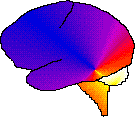

I have a personal fascination with the brain mechanisms that magically transform reflected light into vision. Science is slowly gathering knowledge about these specialized brain regions and the connections between them. As information comes my way about these brain systems, I'll develop this section.
Since a large percentage of the human brain (50% at the very least) is involved with vision, it is reasonable to ask how blindness affects brain processing, especially for the developing brain. If the vision system is neurologically connected to every lobe and major processing area of the brain, then what happens to all these connections, all this brain power, when no visual signals are received?
One answer is that throughout evolution, the vision system evolved in parallel with the tactile (haptic) system. The eye and the hand, for example, co-evolved over a long span of human evolution. The result of this parallel development is that a large proportion of tactile signals (90%?) go to visual centers. This helps explain way the visual cortex is functioning when blind individuals use Braille. Studies at the National Institute of Neurological Disorders and Stroke, for example, show that blind people reading Braille use the visual cortex for processing. When Helen Keller's brain was analyzed after her death, it was found that all her brain areas were viable, there was no atrophy in the visual centers.
There is a great deal we do not know about brain processing and blindness. One of the goals of this section is to record what we do know (and add to our knowledge as information becomes available). Although the brain is a network of interconnecting, crisscrossing nerve tracts, functional areas have been identified and are discussed below. Areas were selected for discussion if their function was related to visual processing, navigation, or mobility. Particular concern is given to the consequences of visual loss.

 The Cerebellum
The Cerebellum
